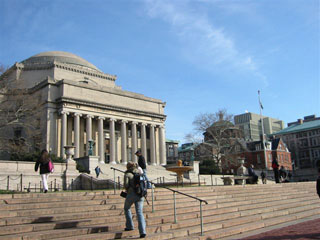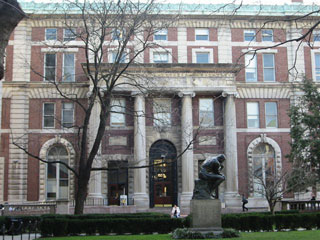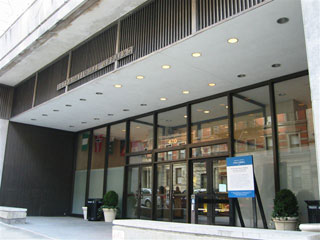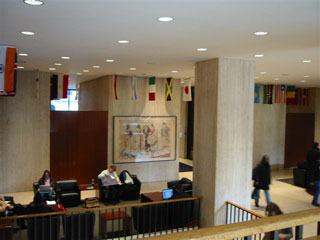1/May/07

The Law Library, symbol of Columbia University.
Today it is used
as a lecture hall rather than as a library.
Manhattan and People of Asian Origin
Manhattan is a graphic representation of the United States as a gmelting
poth of people of diverse origins. The driver of the taxi I happened
to be riding in one day was a middle-aged man who, unusually for his
profession, had been born and raised in Manhattan. He told me that
he had never traveled outside the United States (with the exception
of Canada). gI have never needed to,h he explained, gbecause people
from all over the world come to me and tell me lots of different things.h
Manhattan is fairly clearly divided along ethnic lines geographically,
as people of the same race tend to live close by one another. In many
places you can tell from those using a particular subway station what
nationalities and groups live in the area around. Certain districts
are actually called Chinatown and Korea-town and so on, so it is relatively
easy to come into contact Asian people living in Manhattan, especially
Chinese and Koreans. There is even a small-scale India-town of a couple
of streets, though most people from the subcontinent tend to live in
Queens. The Manhattan Chinatown has now even overtaken its counterpart
in San Francisco in size. It certainly seems more active and energetic
than the Chinatowns in Yokohama and Kobe, though less defined. I often
came across groups of primary and secondary school students from Manhattan
visiting the area for social studies or sketching, and whereas usually
there were one or two Asian children gmixedh within predominantly children
of Caucasian or African descent, near Chinatown all the pupils appeared
to be Chinese. People in nearby subway stations too almost all spoke
Chinese.
A good proportion of the Japanese in Manhattan live in the East Village, in
the southeast of the island. That is where I lived as well. Certainly there
is a greater concentration here of Japanese stores and restaurants, and there
are many Japanese on the streets. However unlike other ethnic areas, there
are more links between people living here and those in other areas. The Japanese
are in fact spread out all over New York, both in Manhattan and beyond and
most who go to live in the East Village, like students, seem to do so (at least
initially) because it is somewhere temporary to stay. I think their intention
is different from those who migrate to New York and want to live in an area
dominated by people of their own background, where they can settle down and
find a job.
I had heard before I went to New York that it was very interesting how certain work there tended to be divided among members of specific ethnic groups, and I definitely found that observation to be accurate. Of course I also found that across the broad spectrum of the professions, like medicine and teaching, and the service industry in Manhattan that all kinds of races and ethnic groups were represented. All the same, taxi drivers tended to be black, with people from the Indian subcontinent the next largest group, while managers of, and workers in, delicatessans and small food stores were most often of a Korean background. Also I was very interested to find that shops identified in some way as gJapaneseh were generally run by Chinese or Koreans. They were the main groups who operated sushi restaurants and food delivery services in Manhattan, often combining the provision of Chinese and Japanese food into combined gChinese and Japanese Restaurants.h It was not strange for clearly non-Japanese actors to appear as Japanese on television commercials and in other types of advertisement. There is some doubt then about how accurately the image of Japan is being presented. In this sense too, the Japanese in New York are a minority within a minority. On the other hand, in department stores and such places if you mention you are Japanese the clerk, even an imposing looking black man, will immediately say garigatoh (thank you), and the female clerks often ask how to say a certain thing in Japanese. You often see what appear to be groups of Chinese or Korean tourists in Manhattan, but it is the Japanese tourists who are considered the ggood customersh par excellence.
Columbia University and Asian Studies
Columbia University is located in the northwestern part of Manhattan.
It conducts a continual and wide-ranging program of symposia, public
lectures and exhibitions, and in September 2005 for example, addresses
were given there by the Pakistani President, General Musharraf, President
Talabani of Iraq, President Yudhoyono of Indonesia and the Dalai
Lama. The university is very active in inviting world leaders to
speak when they are in New York to attend the General Assembly of
the United Nations.
There are twenty-five libraries belonging to or affiliated with Columbia
University, and all possess materials related to Asia and Asian Studies
to a greater
or lesser extent. Two in particular have large collections of Asian works.
These
are the Lehman Library and the C. V. Starr East Asian Library. The Lehman
Library has books and materials related to Area Studies, and the offices
of the various
librarians associated with each area are located here. The C. V. Starr
East Asian Library is more than a hundred years old and was donated
initially
to house the universityfs Chinese collection. Today it contains books and
other materials from China, Japan, Korea and other Asian countries,
as well as
newspapers,
dictionaries, statistical material and academic journals for the use of
researchers. Large numbers of people of Asian descent and well as students
and scholars
of Asian Studies use the library.

C. V. Starr East Asian Library.
I was attached to SIPA (School of International and Public Affairs) at Columbia.
It was founded as a Graduate School in 1946, offering a masterfs degree in
International Affairs (MIA). A quick look at the 2004 register reveals that
there were around 1300 students enrolled that year. (The total student population
of Columbia is between 24,000 and 25,000.) About fifteen percent of them would,
I judge, be Asian, including students from Western Asia and the Commonwealth
of Independent States (CIS, the republics of the former Soviet Union). Chinese,
Japanese and Korean students are particularly conspicuous. Even more students
from both within and without Columbia attend lectures at SIPA as auditors or
as part of their postgraduate training.

Entrance to SIPA.
SIPA offers two masters programs, MIA (Master of International Affairs)
and MPA (Master of Public Administration), as well as, since 2004,
a doctorate
in Sustainable Development. In Autumn 2005, for example, students were
offered, besides language courses, a wide variety of subjects concerning
Asia (lectures
given within Columbia both inside and outside SIPA are counted as individual
units). These included:
EKorean Foreign Relations
EChinafs New Marketplace
ETraditional Japanese Architecture
EFilm and Television in Modern Tibet
EPopular Religion in East Asia
EAdvanced Study -South Asian History and Culture
EThe Economic and Social Geography of Central Asia
ENationalism in the Arab World
EUS Relations with East Asia
EChinese Politics
EPolitics of Southeast Asia
EChinese and Tibetan Relations in History
EThe Persian Gulf in the Twentieth Century
EIslamic Law and Middle Eastern Legal Institutions

SIPA lobby.
The painting on the central wall is influenced by
traditional East Asian art
Organizations connected with Asian research at SIPA consist in the
main of the following:
The Russian Institute (now part of the Harriman Institute): An academic center
to study Russia and the Soviet Union in an interdisciplinary way, first set
up in 1946.
The Middle East Institute of Columbia University (established 1954): Covers
the Arab countries, Armenia, Iran, Israel, Turkey, Central Asia and the Muslim
Diaspora Community.
The Weatherhead East Asia Institute (established 1949): Deals with
China, Japan, Taiwan, Hong Kong, the Korean Peninsula, and the countries
of Southeast Asia.
The Southern Asian Institute (established 1967): Incorporates India, Pakistan,
Bangladesh, Sri Lanka, Nepal, Bhutan and the Maldives.
Many SIPA graduates work for international bodies like the United Nations, NGOs, and the governments of their own countries. This is a natural consequence of SIPAfs emphasis on international affairs and public administration. From a researcherfs point of view, an interesting question is how SIPA, which deals equally with business practice and research, will in the future strengthen the relationship between international relations and public administration, with their attendant topics and issues, on the one hand, and studies of Asia and other areas, on the other.
¦The information in this article was collected by the author while
studying at Columbia University in the academic year 2005-2006 under
a Fulbright scholarship (Doctoral dissertation program).